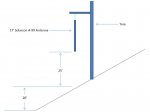I have several vertical antenna questions but I'm going to start with height first. Not a question of how high is best but simply, "how high is this antenna?" (see diagram)
I live on the side of a mountain about 3,600' above sea level. There is very little flat ground around where the antenna can be installed so I have it hanging from a tree (on the side of the mountain) with the bottom of the antenna about 25' above the (sloped) ground. From that point it's another 20' to a wide section of flat ground below.
There are no radials on the antenna at this time. I bought the radial kit and installed it but there was no difference in transmit or receive quality so I took them off for now. I plan to experiment with different locations and higher trees and at that time I'll try them again.
In anticipation I'll answer some expected questions.
(*) I chose the Solarcon A-99 because it's an inexpensive antenna to experiment with. If I get positive results I'll probably upgrade to a better performing antenna but if I don't, I won't loose any sleep over what I spent on this one.
(*) I've been using a 10 meter dipole but my local ham club is starting up an HF net and almost everyone is getting better results with a vertical. We're all between 30-50 miles apart. I've tried both the dipole and vertical and I'm in agreement, for some reason the vertical is out performing the dipole hands down.
(*) We are all in mountainous areas and most of us are over 2,500' above sea level.
The big problem at this time is I don't know what I don't know. And to start with, I don't know how high above ground this antenna actually is. My goal is to place it at approximately 1.5 wavelength above ground, or about 53' for 10 meters. But with so much sloped ground below the antenna I don't know what to expect the radiation pattern to look like.
So how high is this antenna now? Is it 25' high or is it 45' high?
Thanks in advance!
I live on the side of a mountain about 3,600' above sea level. There is very little flat ground around where the antenna can be installed so I have it hanging from a tree (on the side of the mountain) with the bottom of the antenna about 25' above the (sloped) ground. From that point it's another 20' to a wide section of flat ground below.
There are no radials on the antenna at this time. I bought the radial kit and installed it but there was no difference in transmit or receive quality so I took them off for now. I plan to experiment with different locations and higher trees and at that time I'll try them again.
In anticipation I'll answer some expected questions.
(*) I chose the Solarcon A-99 because it's an inexpensive antenna to experiment with. If I get positive results I'll probably upgrade to a better performing antenna but if I don't, I won't loose any sleep over what I spent on this one.
(*) I've been using a 10 meter dipole but my local ham club is starting up an HF net and almost everyone is getting better results with a vertical. We're all between 30-50 miles apart. I've tried both the dipole and vertical and I'm in agreement, for some reason the vertical is out performing the dipole hands down.
(*) We are all in mountainous areas and most of us are over 2,500' above sea level.
The big problem at this time is I don't know what I don't know. And to start with, I don't know how high above ground this antenna actually is. My goal is to place it at approximately 1.5 wavelength above ground, or about 53' for 10 meters. But with so much sloped ground below the antenna I don't know what to expect the radiation pattern to look like.
So how high is this antenna now? Is it 25' high or is it 45' high?
Thanks in advance!
Attachments
Last edited:


